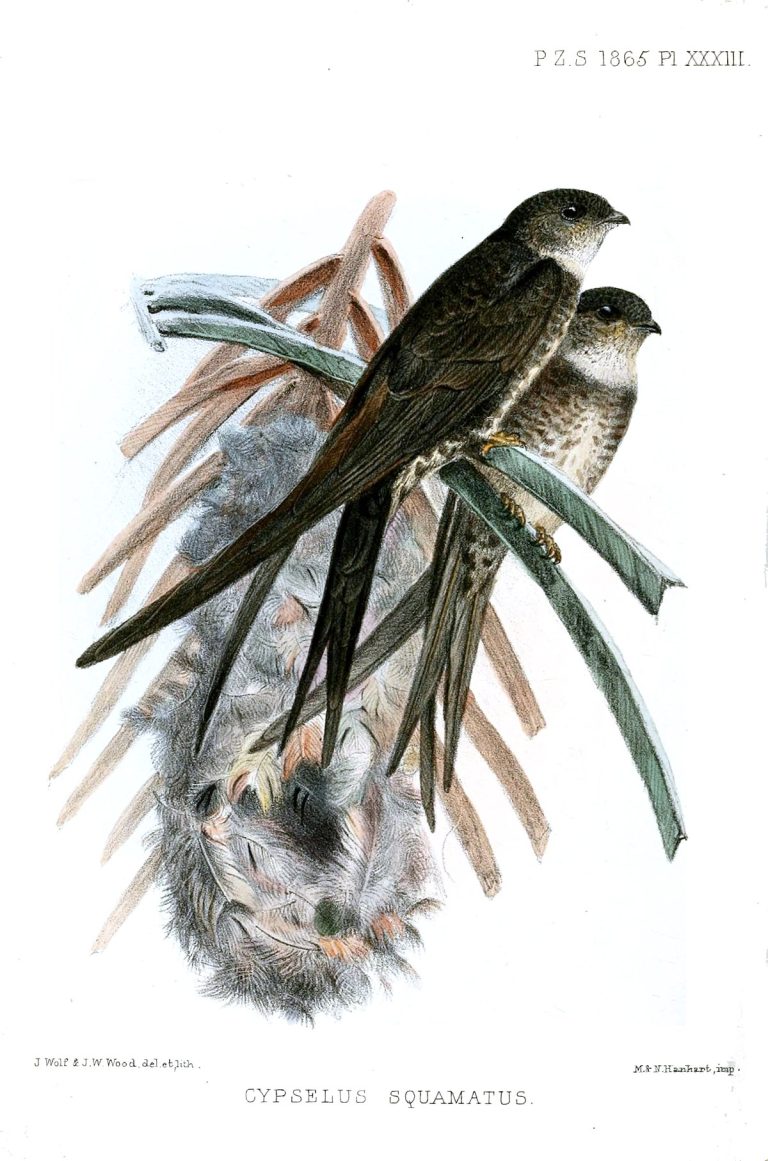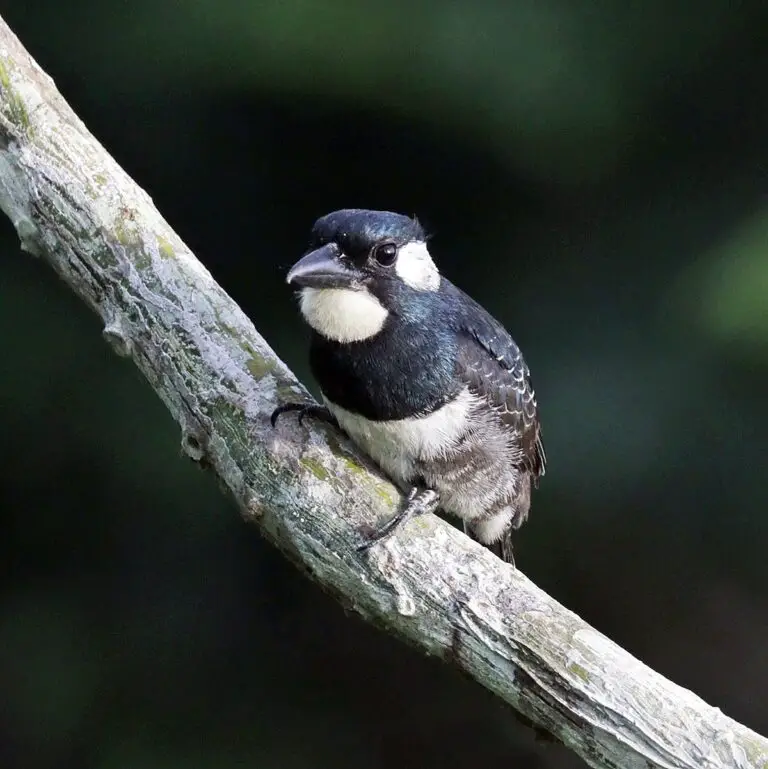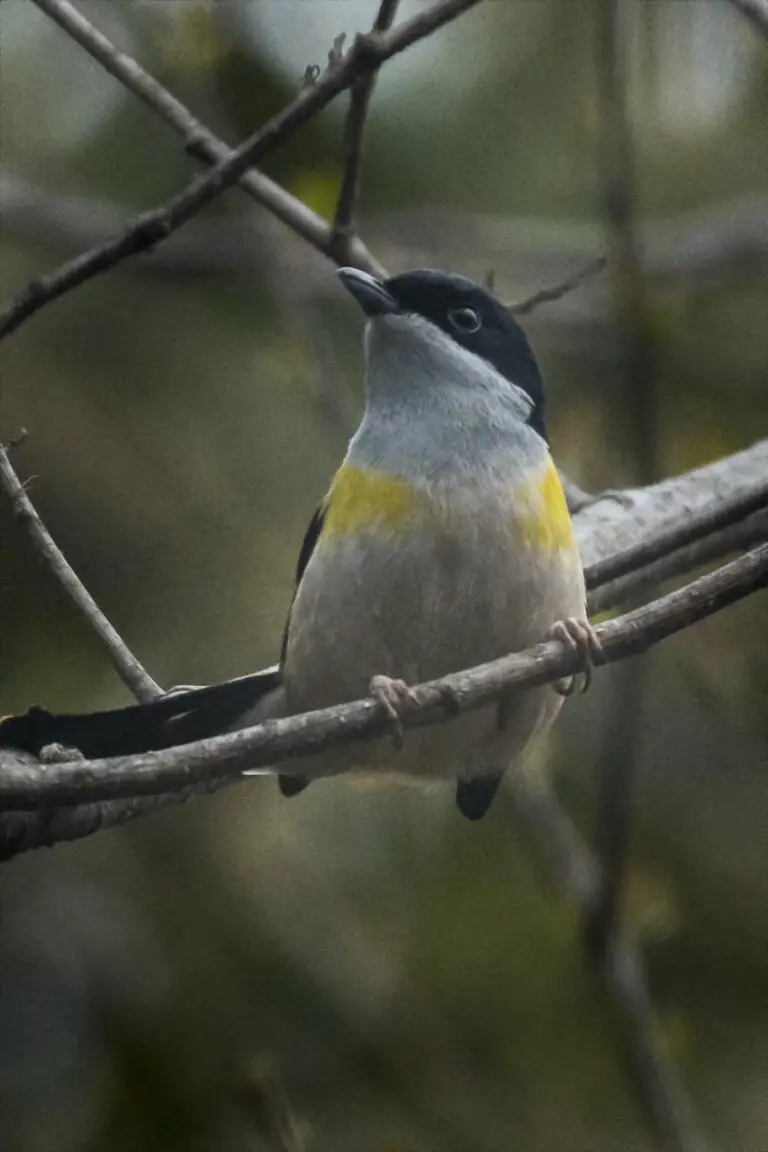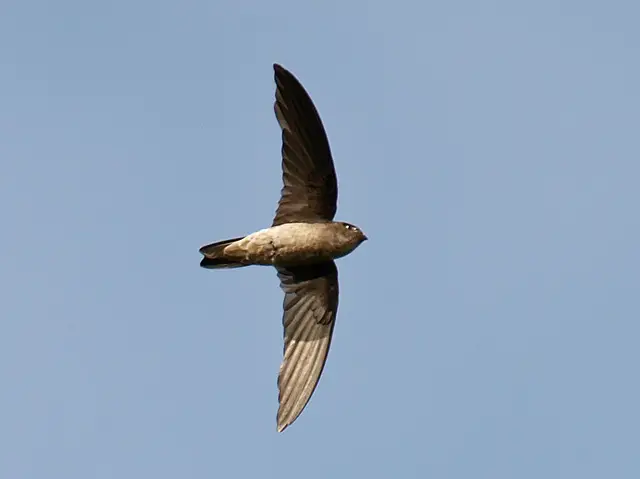Peacock
“A group of peafowls is called a muster.”
Peacocks, scientifically classified under the genus Pavo, belong to the following taxonomical hierarchy:
- Kingdom: Animalia
- Phylum: Chordata
- Class: Aves
- Order: Galliformes
- Family: Phasianidae
- Genus: Pavo
As for their conservation status, peacocks are categorized as “Least Concern” by the International Union for Conservation of Nature (IUCN). This status indicates that they are not currently facing any significant threat of extinction.
Peacocks are native to both Africa and Asia, with different species and subspecies found across various regions of these continents. They are often associated with their vibrant plumage and are commonly found in forests, grasslands, and other wooded areas.
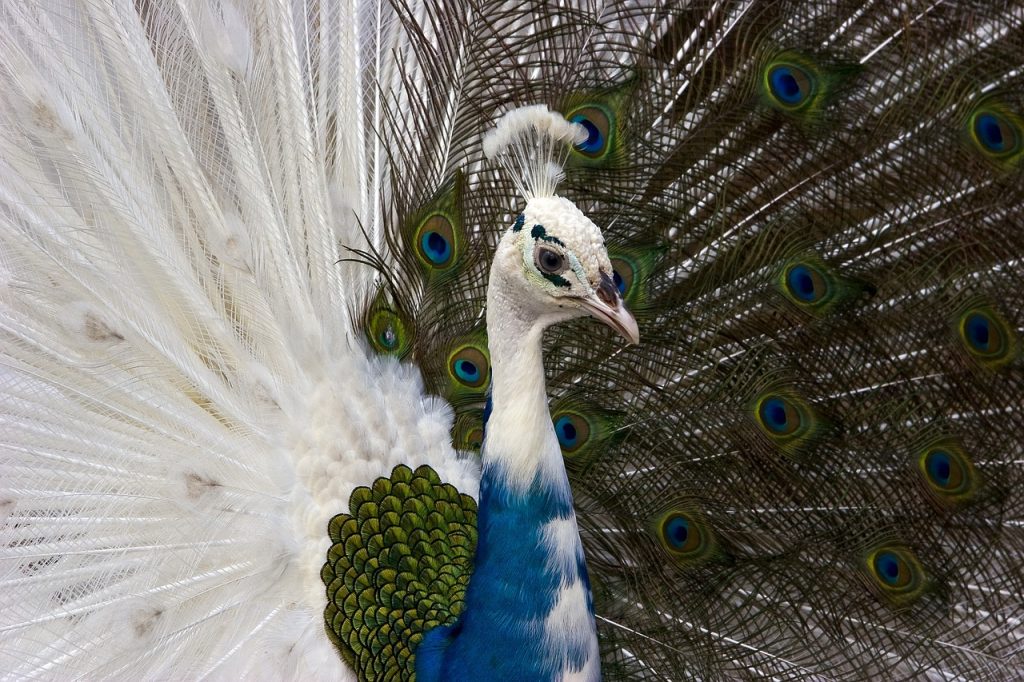
Peacock Facts:
Main Prey: Peafowls predominantly feed on grains, seeds, and insects, crafting a varied omnivorous diet.
Fun Fact: A gathering of peafowls is whimsically referred to as a “muster,” adding a touch of charm to these elegant birds’ collective presence.
Distinctive Feature: The striking long tail feathers and vibrant, colorful tails of male peafowls serve as iconic symbols of their beauty and allure.
Wingspan: Peacocks boast an impressive wingspan ranging from 3 to 10 feet, allowing for graceful flight and majestic displays.
Incubation Period: The incubation period for peafowl eggs typically spans 27 to 30 days, during which attentive parents diligently tend to their clutch.
Habitat: Peafowls thrive in desert and savanna areas, adapting to diverse landscapes with their resilient nature.
Predators: Despite their majestic appearance, peafowls face threats from predators such as dogs, raccoons, tigers, and wild cats.
Diet: As omnivores, peafowls enjoy a varied diet encompassing grains, seeds, and insects, showcasing their adaptability to different food sources.
Lifestyle: Peafowls tend to lead solitary lives, gracefully navigating their habitats with an air of independence.
Favorite Food: Grains hold a special place in the hearts of peafowls, constituting a favored component of their diet.
Type: Peafowls belong to the avian family, known for their distinctive plumage and captivating displays.
Average Clutch Size: Peafowls typically lay clutches of around 6 eggs, nurturing the next generation with care and devotion.
Slogan: “Most commonly found on the Indian mainland!” serves as a fitting tribute to the widespread presence of peafowls in their native habitats.
Nesting Location: Ground nesting is a common practice among peafowls, who carefully select suitable sites to safeguard their eggs and offspring.
Age of Molting: Peafowls undergo molting at around 3 years of age, shedding old feathers to make way for new growth.
Physical Characteristics:
Color: Peafowls exhibit a stunning array of colors, including brown, grey, blue, and green, accentuating their natural beauty.
Skin Type: Feathers envelop the skin of peafowls, serving as both protection and adornment for these majestic birds.
Top Speed: While not renowned for their speed, peafowls can reach speeds of up to 10 mph when necessary.
Lifespan: Peafowls typically live between 12 to 20 years, gracefully traversing their habitats with grace and resilience.
Weight: Ranging from 2.7 kg to 6 kg (6 lbs to 13.2 lbs), peafowls display a range of weights reflecting their diverse sizes and genetic variations.
Length: With lengths spanning from 86 cm to 107 cm (34 in to 42 in), peafowls captivate onlookers with their elegant stature and majestic presence.
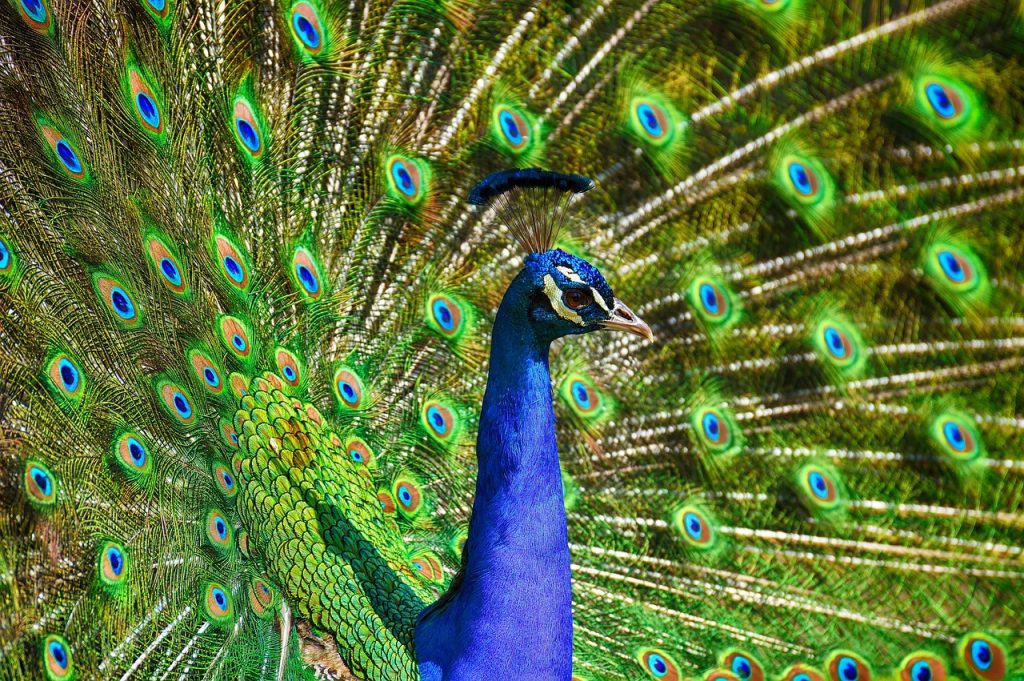
Peacocks, renowned for their grandeur and splendor, are celebrated as some of the largest flying birds on our planet. Their striking beauty is epitomized by the dazzling display of iridescent tail feathers, a feature that captivates the imagination of admirers worldwide. However, it’s important to note that this resplendent plumage is exclusive to male peafowls, serving as a breathtaking emblem of their magnificence.
While the vivid blue hues of the Indian peacock are often the quintessential image that comes to mind, it’s worth noting that there exists a remarkable diversity among peacock species. Not all peafowls boast the same expansive plumage; some species exhibit variations in size and coloration, showcasing a spectrum of captivating traits that enrich the tapestry of avian beauty.
Indeed, whether adorned in the majestic hues of the Indian peacock or adorned with the more subdued plumage of other species, peafowls continue to enchant and inspire with their regal presence and unparalleled grace.
Amazing Peacock facts!
Peacocks employ their exquisite plumage as a dual-purpose tool in the intricate dance of survival. Not only do their vibrant feathers serve as a captivating display to woo potential mates, but they also function as a formidable deterrent against would-be predators by creating the illusion of a larger, more imposing presence.
The distinctive eye-like patterns adorning their tail feathers are aptly named ocelli, adding a mesmerizing allure to their already striking appearance.
Recognizing the importance of preserving these majestic birds, peafowls have been granted protection under the 1972 Indian Wildlife Act, safeguarding them from harm and exploitation.
In the company of their own kind, peafowls are known by various collective nouns, such as a muster, pride, or ostentation, reflecting the regal charm and communal nature of these magnificent creatures.
And amidst the kaleidoscope of colors found in the natural world, the striking blue hues of peacocks stand out as a rare and precious gem. Indeed, blue is a rarity in nature, making peacocks among the select few blue animals gracing the diverse tapestry of life on Earth.
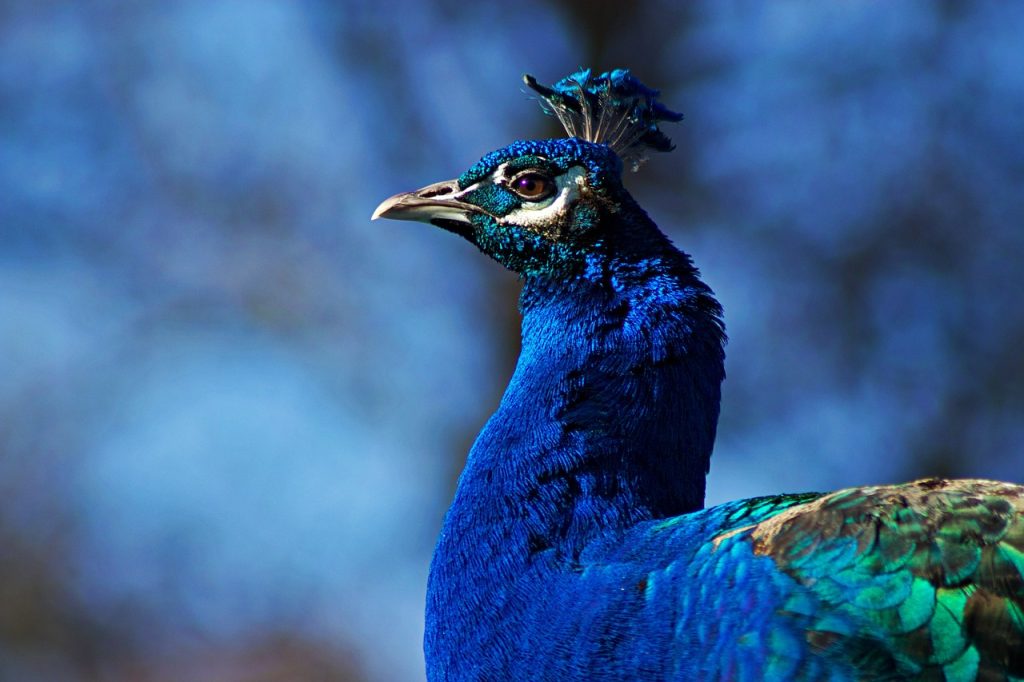
Where To Find Them
Peafowls, with their origins rooted in Asia, hold a special place in the rich tapestry of wildlife, particularly in the vibrant landscapes of India. The iconic blue peacock, synonymous with India’s cultural heritage, proudly displays its resplendent plumage across the country’s expansive terrain, earning it the moniker of Indian peacock or peafowl.
Beyond the borders of Asia, these magnificent birds also find a home in the wilds of Africa, where the lesser-known Congo peacock adds its own unique charm to the continent’s diverse fauna. Additionally, pockets of peafowl populations can be found in select areas of Australia, where they lend their grace to the sun-kissed landscapes of the Outback.
Peafowls exhibit a preference for warm climates, thriving in habitats such as deserts and savannahs where the sun’s rays beat down with gentle warmth. The summer months herald the breeding season, offering prime opportunities for observing these majestic birds in their full splendor. Their peak activity periods, typically in the morning and around dusk, provide glimpses into their enchanting world.
While forests provide an ideal habitat for peafowls, they also adapt well to human settings, including zoos around the world. Here, captive peafowls, often of the Indian variety, enchant visitors with their beauty and grace, serving as ambassadors for their wild counterparts.
Beyond the confines of zoological institutions, peafowls also find companionship in the hearts of individuals who choose to welcome them into their homes and farms as beloved pets, further enriching the intricate tapestry of human-animal relationships. Indeed, whether in the wild or in the company of humans, peafowls continue to captivate hearts and minds with their majestic presence and timeless allure.
Nests
Peahens, the graceful counterparts to their resplendent mates, exhibit a nurturing instinct that extends to their nesting habits. When it comes time to lay their eggs, peahens meticulously craft their nests on the ground, fashioning shallow depressions adorned with soft padding of grass and other natural materials.
These resourceful birds strategically select locations for their nests, often seeking out areas sheltered by bushes, shrubs, or dense vegetation. By nestling their precious eggs amidst the protective embrace of nature’s bounty, peahens aim to safeguard their offspring from the ever-present threat of predators lurking nearby.
In the tranquil sanctuaries of these secluded nests, peahens embark on the journey of motherhood, tending to their eggs with unwavering devotion and care. Through their diligent efforts, they ensure the survival of future generations, perpetuating the timeless cycle of life and renewal in the vibrant tapestry of the natural world.
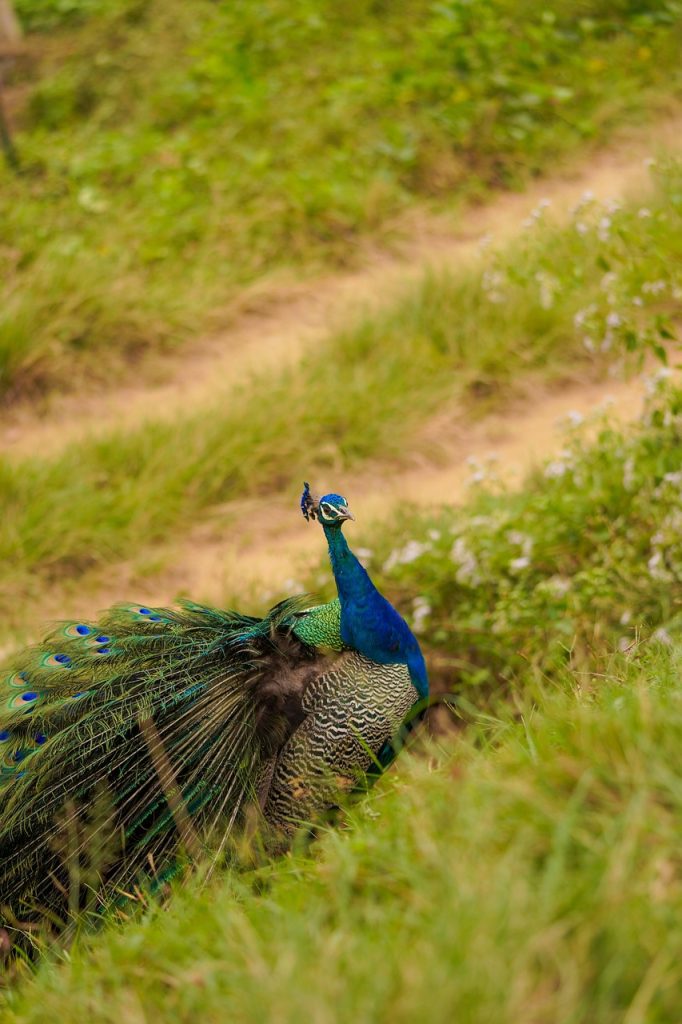
Peafowls, with their striking diversity of colors and captivating beauty, encompass three distinct species, each contributing its own unique charm to the avian realm. Classified within the Aves class and belonging to the Galliformes order, peafowls share a close kinship with pheasants, uniting under the umbrella of the Phasianidae family as ground-dwelling birds.
The Indian Peacock, scientifically known as Pavo cristatus, reigns as the most populous and renowned member of the peafowl family. Originating in India, these majestic birds are celebrated for their resplendent blue plumage, captivating the hearts and imaginations of admirers worldwide.
In contrast, the Green Peafowl, scientifically labeled as Pavo muticus or Indonesian Peafowl, boasts a verdant palette adorning its chest and neck, both in males and females. Native to Indochina and Southeast Asia, these elegant birds exude a tranquil allure amidst the lush landscapes of their native habitats.
Completing the trio is the Congo Peafowl, scientifically referred to as Afropavo congensis or African Peafowl, hailing from the verdant realms of the Congo Basin. While their colors may not rival the vibrancy of their Asian counterparts, these graceful birds exude a quiet dignity and charm that endears them to those who encounter them.
Despite their geographical and aesthetic distinctions, these three species of peafowl share a common lineage, with the Indian and Green peafowls belonging to the Pavo genus, while the Congo Peafowl occupies its own unique niche within the Afropavo genus.
Together, these enchanting birds weave a tapestry of beauty and wonder, enriching the natural world with their presence and captivating the hearts of all who behold their splendor.
History and Evolution
The peacock’s striking physical disparity between males and females has long captivated the curiosity of scientists, with none other than Charles Darwin himself drawn to unraveling the mystery of its elaborate train. Darwin, in his pursuit of understanding evolutionary adaptations, found himself perplexed by the ostentatious display of the male peacock’s vibrant plumage. Despite initially grappling with the notion of how such an extravagant trait could confer any survival advantage, Darwin eventually arrived at the groundbreaking insight that the peacock’s resplendent train served as a powerful tool in the arena of mating. The sheer magnificence of the male’s display, he concluded, outweighed any potential drawbacks posed by the cumbersome nature of its elaborate tail, thus cementing the peacock’s status as a truly remarkable example of natural selection at work.
Renowned for its unparalleled beauty and allure, it comes as no surprise that the peacock holds a place of pride as the national bird of India. Revered for its resplendent plumage, the peacock stands as a symbol of grace, elegance, and divine beauty, enriching the cultural tapestry of India and beyond. Across various mythologies, from the enchanting tales of Greek lore to the rich narratives of Hindu tradition, the peacock emerges as a symbol of majesty and mystique, weaving its iridescent feathers into the fabric of folklore and legend. Indeed, with its breathtaking beauty and storied significance, the peacock reigns supreme as one of the most iconic and revered birds in the entire animal kingdom.
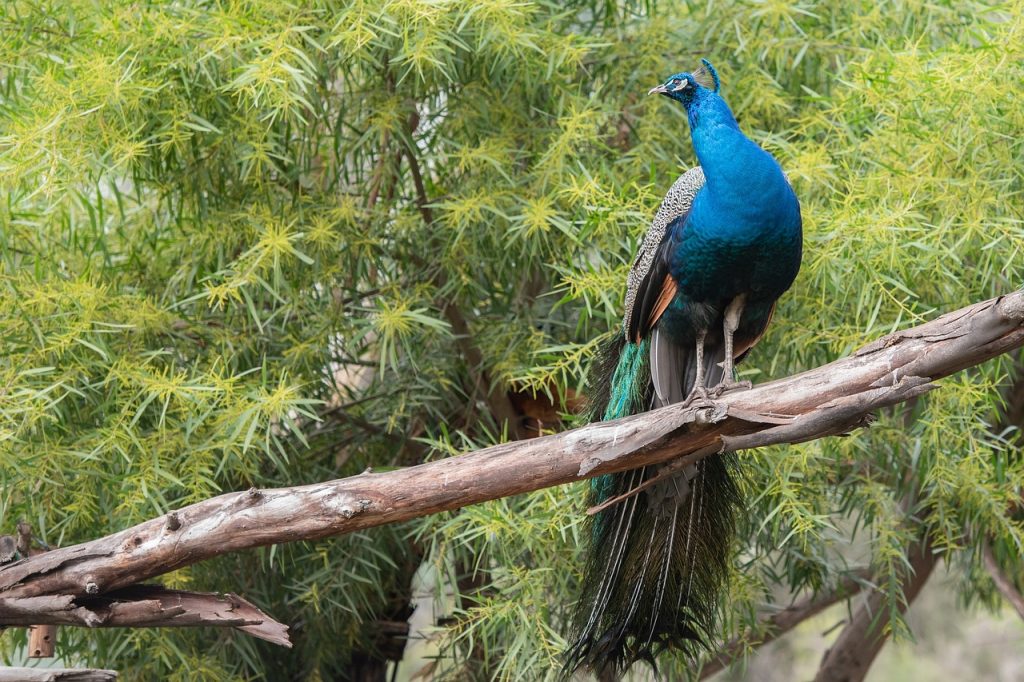
Size, Appearance, & Behavior
Peafowls, with their enchanting diversity of types, exhibit a range of sizes and appearances that reflect their distinct characteristics. Typically weighing between eight and a half to 13 pounds, and measuring anywhere from two to ten feet in length, these majestic birds command attention with their imposing presence. Standing proudly at heights ranging from just under three feet to a little over four feet tall, peafowls epitomize elegance and grace in their stature.
The Indian peacock, resplendent in its beauty, showcases a striking array of colors, with its mesmerizing spots, known as ocelli, adding a touch of allure to its majestic plumage. Similarly, the Green peacock, adorned in hues of verdant green, echoes the splendor of its Indian counterpart when it unfurls its magnificent tail feathers. In contrast, the Congo peacock distinguishes itself with its unique appearance, sporting subdued tones of brown or gray, and featuring a smaller train of tail feathers.
In the realm of peafowls, the females, known as peahens, typically exhibit a more modest size and neutral colors compared to their male counterparts. Devoid of the resplendent tail feather plumage adorning males, peahens exude understated elegance in their appearance. Additionally, some peafowls boast all-white plumage, commonly referred to as albino peacocks. However, true albino individuals are rare, with most white peacocks exhibiting a condition called Leucism, which differs from albinism.
Like many other creatures, peafowls employ sound as a means of communication, utilizing screeching calls to warn of nearby predators and melodious songs as mating calls to attract peahens. The cacophony of sounds produced by peafowls can be deafening, echoing through their habitats with remarkable intensity. Moreover, in moments of defense against predators, peacocks unfurl their majestic train of tail feathers, presenting a formidable spectacle that serves to deter potential threats and assert their dominance in the natural world.
Diet
Peafowls, as omnivores, boast a versatile palate that encompasses both plant-based fare and animal prey.
Their dietary repertoire encompasses a diverse array of plant matter, including grass, roots, flowers, fruits, and seeds, providing them with essential nutrients and sustenance. In addition to their herbaceous diet, peafowls also partake in the consumption of various insects, worms, and amphibians, such as snakes and frogs, supplementing their nutritional intake with protein-rich sources from the animal kingdom.
This eclectic diet ensures that peafowls receive a balanced and varied nutritional profile, enabling them to thrive in their natural habitats and adapt to the ever-changing dynamics of their environment. As opportunistic feeders, peafowls play a vital role in maintaining ecological balance by regulating insect populations and dispersing seeds, thereby contributing to the health and vitality of their ecosystems.
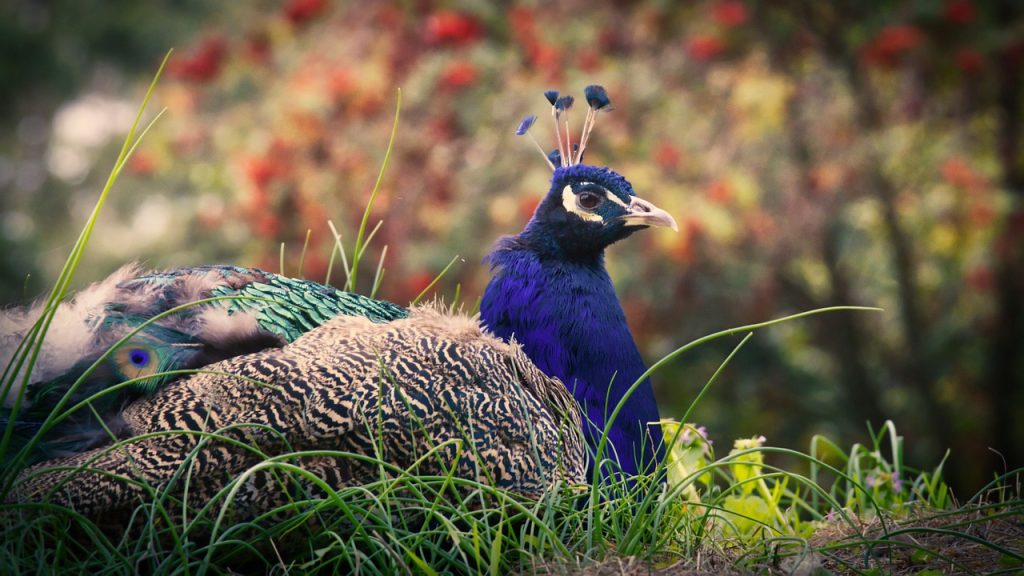
Predators, threats, and conservation status
Peafowls, despite their majestic beauty and formidable presence, face a host of natural predators in their wild habitats, each posing a threat to their survival.
Among the formidable predators that prey on peafowls are wild cats such as tigers and leopards, renowned for their stealth and prowess in hunting. Additionally, wild dogs like the dhole and medium-sized mammals such as raccoons pose significant threats to these birds, preying upon them with relentless determination.
When confronted by predators, peafowls employ various strategies to evade capture, including taking to the skies and seeking refuge in the shelter of trees, leveraging their impressive flight capabilities to outmaneuver their adversaries.
However, perhaps the most significant threat to the well-being of peafowls stems from human activities. Poaching and habitat loss, driven by human encroachment and exploitation, pose grave risks to these magnificent birds, jeopardizing their populations and undermining their continued existence in the wild.
In recognition of the urgent need for conservation action, concerted efforts have been made to safeguard peafowl populations and mitigate the threats they face. Protective legislation, establishment of animal sanctuaries, implementation of captive breeding programs, and ongoing research and education initiatives all play crucial roles in ensuring the preservation of these fascinating creatures.
Through collaborative conservation endeavors and heightened awareness of the challenges confronting peafowls, humans can make a meaningful difference in safeguarding the future of these iconic birds, securing their rightful place in the tapestry of life on Earth.
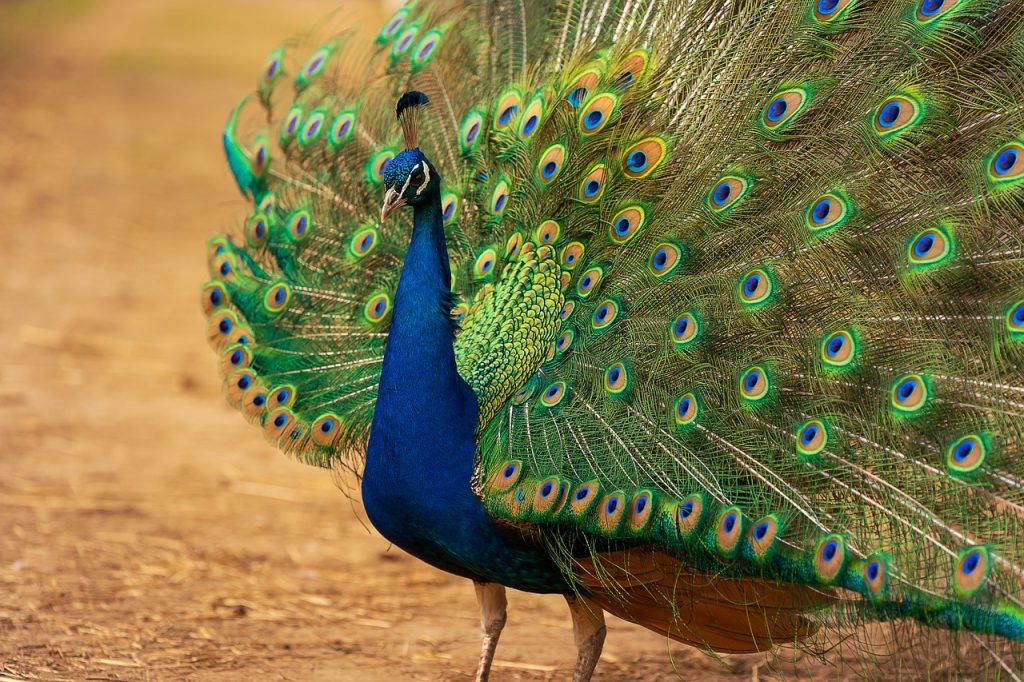
Reproduction, Babies, and Lifespan
During mating season, peacocks engage in a fascinating courtship ritual, seeking out multiple peahens with which to mate. The mating process involves the alignment of their cloacas, the reproductive organs, facilitating the transfer of genetic material and fertilization.
Once a peahen lays her eggs, she assumes the responsibility of incubating them, diligently tending to her precious clutch with maternal care and devotion. The incubation period typically spans between 27 and 30 days, during which time the peahen remains steadfast in her commitment to nurturing the developing embryos.
Upon hatching, the young offspring, known as peachicks, emerge into the world, equipped with the remarkable ability to walk mere days or even moments after their arrival. As they mature, peachicks gradually acquire the capacity to fly short distances, embarking on the journey of exploration and discovery under the watchful gaze of their vigilant mother.
At the age of three, peachicks commence the molting process, shedding their juvenile feathers in favor of new plumage that emerges with remarkable swiftness. With a typical lifespan ranging between 12 and 20 years in the wild, peafowls have been known to exceed this lifespan in captivity, where they receive attentive care and thrive in conducive environments.
Through the intricate tapestry of life, peafowls traverse the cycles of birth, growth, and renewal, embodying the resilience and beauty inherent in the natural world. With each generation, they perpetuate the legacy of their species, enriching the landscape with their vibrant presence and enduring spirit.
Population
The Indian peafowl, with its robust population exceeding 100,000 individuals worldwide, enjoys a status of least concern, indicative of a thriving population that faces no immediate threat to its existence. In contrast, the Green peacock teeters on the brink of endangerment, with fewer than 30,000 remaining in the wild, signaling a pressing need for conservation efforts to safeguard its future. Similarly, the Congo peafowl, with numbers dwindling below 10,000, finds itself classified as vulnerable, highlighting the precarious state of its population and the urgent need for intervention to mitigate the threats of habitat loss and population decline. As stewards of the natural world, concerted conservation endeavors are imperative to ensure the continued survival and well-being of these magnificent birds, preserving their place in the rich tapestry of biodiversity for generations to come.
Conclusion
The peacock stands as a symbol of natural splendor and magnificence, captivating the imagination with its resplendent plumage and majestic presence. From the vibrant hues of the Indian peafowl to the exotic allure of the Green and Congo peafowls, these birds epitomize the beauty of the natural world. While the Indian peafowl thrives in its least concern status, the Green and Congo peafowls face challenges, with declining populations underscoring the need for conservation efforts. Through dedicated conservation initiatives and heightened awareness, we can ensure the preservation of these iconic birds, safeguarding their legacy for future generations to marvel at and cherish.
